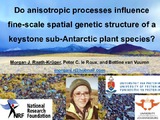
Antarctic Legacy Archive
Do Anisotropic Processes Influence Fine-Scale Spatial GeneticStructure Of A Keystone Sub-Antarctic Plant Species?
- ALSA Home
- →
- Documents
- →
- Research Events
- →
- View Item
JavaScript is disabled for your browser. Some features of this site may not work without it.
| dc.contributor.author | Raath-Kruger, Morgan | |
| dc.contributor.author | Le Roux, Peter | |
| dc.contributor.author | Van Vuuren, Bettine | |
| dc.date.accessioned | 2022-08-16T07:49:34Z | |
| dc.date.available | 2022-08-16T07:49:34Z | |
| dc.date.created | 2022-08-08 | |
| dc.identifier.uri | http://hdl.handle.net/123456789/28775 | |
| dc.description.abstract | Accurate predictions of how climate change will affect all aspects of our planet, including changes in species’ ranges, are needed. While changes in temperature and rainfall have received the majority of research attention, there is a relatively poor understanding of how variation in wind speed and direction may impact biotic communities, particularly through their influence on dispersal and gene flow. Limited seed or pollen dispersal enhances genetic relatedness between nearby individuals and/or populations (fi ne-scale spatial genetic structure, SGS), with genetic differentiation between populations or pairs of individuals generally increasing as a function of the spatial distance between them. However, this pattern of fi ne-scale SGS may not always occur isotropically when spatially asymmetric processes, e.g., windspeed and direction, are important. Consequently, a greater understanding of the anisotropic drivers of spatial patterns of dispersal, particularly at local spatial scales, is needed. Therefore, we use molecular tools in conjunction with an advanced fluid dynamics model of wind flow and an extensive ecological dataset to understand the drivers of observed fi ne-scale ecological and genetic patterns. We genotyped 160 Azorella selago specimens, a widespread, wind-dispersed and wind-pollinated cushion plant species, from four populations located on a landform. We specifically assess the efficacy of combining SGS analyses with anisotropic spatial autocorrelation techniques to infer the impact of changing wind fl ow patterns on local-scale colonization and up-slope dispersal processes in these plants. We use sub-Antarctic Marion Island as a model system as the island’s landscape is exceptionally heterogeneous and has experienced recent rapid changes in climate. | en_ZA |
| dc.description.sponsorship | Sponsored by the the Department of Science and Innovation(DSI) through National Research Foundation (NRF) - South Africa | en_ZA |
| dc.description.statementofresponsibility | Antarctic Legacy of South Africa | en_ZA |
| dc.language | English | en_ZA |
| dc.language.iso | en_ZA | en_ZA |
| dc.relation | SCAR 10th Open Science Conference - 2022 | |
| dc.rights | Copyright | en_ZA |
| dc.subject | Research - Biology | en_ZA |
| dc.subject | Research - Genetics | en_ZA |
| dc.subject | Research - Botany | en_ZA |
| dc.title | Do Anisotropic Processes Influence Fine-Scale Spatial GeneticStructure Of A Keystone Sub-Antarctic Plant Species? | en_ZA |
| dc.type | Presentation | en_ZA |
| dc.rights.holder | Morgan Raath-Kruger | en_ZA |
| iso19115.mdconstraints.uselimitation | This item and the content of this website are subject to copyright protection. Reproduction of the content, or any part of it, other than for research, academic or non-commercial use is prohibited without prior consent from the copyright holder. | en_ZA |
| iso19115.mdidentification.deliverypoint | Antarctic Legacy of South Africa, Faculty of Science, Private Bag X1, Matieland. Stellenbosch. South Africa. | en_ZA |
| iso19115.mdidentification.electronicmailaddress | antarcticlegacy@sun.ac.za | en_ZA |
Files in this item
This item appears in the following Collection(s)
-
Research Events [502]
Material directly related to official scientific and research events
